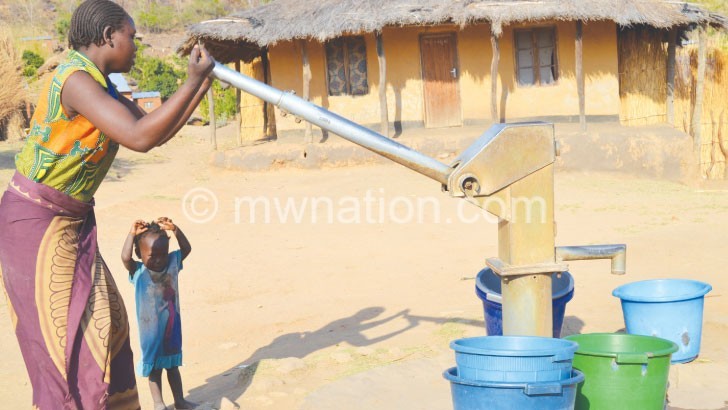Mpira Dam dries up, communities suffer
By 3am everyday, Dalisi Fuleza sets out on a journey to search for water from a nearby borehole.
“You have to come early or else the day will go without a bucket of water,” she exclaims.

On this Thursday afternoon, we found Fuleza seated under a tree. At a distance was her 20-litre empty bucket in a queue among others at the borehole.
Dusk was already building up, but the borehole was still dry. Fuleza says she had been in the queue from around 3am.
“Now it is 5pm and I still don’t have water,” she says sounding helpless. “After one person, you have to wait for hours for another person to draw water because it seems water is too deep for the borehole to pump.”
Fuleza is one of the people in Traditional Authority (TA) Phambala in Ntcheu who have been reduced to long hours of searching for water due to the drying up of Mpira Dam in the district.
The water levels have dropped to a record low.
There are a number of boreholes in the vicinity, but they were all drilled based on water levels in the dam. Thus, water output has been receding with the lowering of water levels in the dam.
It now takes an average of three hours to fill a 20-litre bucket. The pumping is supposed to be done once every hour, otherwise the borehole will be dry the whole day.
By 5pm, Fuleza and four others had no option but to abandon the queue and walk about half a kilometre to draw water from the remaining muddy water at the dam.
“It is a health risk to consume this muddy water, but we have no option,” says Fuleza.
Village head Gomeza says the situation has been worsening gradually and they notified authorities in time, but nothing was done.
“We have only two boreholes here serving six villages. The only way to survive is to fetch polluted water from the dam,” he says.
But Ntcheu district commissioner Smart Gwedemula says his office has not received any complaint from the communities.
He is, however, optimistic that the situation will improve due to rains the district has been receiving in the past few days.
Gwedemula says there are already interventions to protect the dam from drying up in future. He says government has engaged a consultant to work on designs towards rehabilitation of the dam under the Shire River Basin Management Project.
Where are we coming from?
The dam has been around for more than two decades. Its construction began in March 1986 and finished in March 1993. It has a total capacity of 3.72 million cubic metres and is able to supply water for domestic use to over 500 000 people.
Sources indicate that the dam came into being through the Balaka Rural Water Supply Project conceived to provide rural communities with potable water.
A feasibility study funded by United Nations Development Programme (UNDP) was completed in 1981 and the project was approved in 1984. In 1988, the government relocated people around the dam to protect its catchment area.
Allan Ntsitsamwaye, 78, has been around and his family is among those that were relocated in 1988 to pave way for the dam project. He received K10 000 as compensation from government. He now lives with his family at Bamba Village in the district.
On the particular day, Ntsitsamwaye was among the people visiting the dam, having heard it has dried up. He was shocked by the state of the facility.
He reacted in disbelief: “Oh no!”
Ntsitsamwaye blames lack of proper care for the dam.
“I was here when the project started. This used to be the river and government blocked it and erected structures to capture water into the dam,” he recalls. “This is the first time I am seeing the dam drying up to this point. Government has failed us here.”
Mpira Dam scheme manager Samuel Khomani says management of the dam is compromised by conflicting policies. He says Forestry Department harvested all the trees around the catchment area and disregarded the future of the dam. There are no trees around the dam now.
“Different ministries have different interests on this dam and this is affecting our work on the dam,” he laments.
Failing to protect last standing water sources does not only punish the communities but poses a gloomy future. There are fears that if nothing is done, water sources will continue to deplete and it is sad that government is watching its reliable water sources disappearing.
This is against global goals, particularly Sustainable Development Goals (SDGs) goal number six which urges nations to ensure there is clean water and sanitation for all.
Sadly, the story about Mpira Dam comes months after a number of wetlands, including Malawi’s second largest lake, Lake Chilwa, have been declared zero water.
All eyes are now in the sky hoping for more rains to fill the dam again, which when in shape, serves 61 primary and secondary schools, 11 health centres through 2110 communal water sources and over 814 private connections. n





